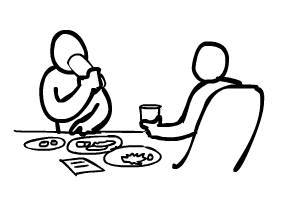 I'm in the process of doing a Current State Value Stream Mapping (VSM) for the PMO. The big questions are, based on the current state, are there areas we can improve? Can we eliminate any waste (or increase efficiencies) from our current processes? The answer to both questions is YES. Everyone should be reviewing there processes on a regular basis, giving themselves opportunities to become more profitable. Though I'm advising a Federal Government project, the American people still deserve the most bangs for their bucks.
Today is the last day for one of my projects. It is done. Now is the time to see what worked and what did not. We now need to do a retrospective and see if we learned any lessons from the last go-around. I will give the vendor credit on this particular project. This small cross-functional team did a better job than others, in part, because we had a daily 15 minute status meeting. (otNay allowedway otay entionmay Agileway). One of the other program teams wastes so much time because they only communicate once a week in a 3 hour meeting. I hope my VSM will change that.
I'm in the process of doing a Current State Value Stream Mapping (VSM) for the PMO. The big questions are, based on the current state, are there areas we can improve? Can we eliminate any waste (or increase efficiencies) from our current processes? The answer to both questions is YES. Everyone should be reviewing there processes on a regular basis, giving themselves opportunities to become more profitable. Though I'm advising a Federal Government project, the American people still deserve the most bangs for their bucks.
Today is the last day for one of my projects. It is done. Now is the time to see what worked and what did not. We now need to do a retrospective and see if we learned any lessons from the last go-around. I will give the vendor credit on this particular project. This small cross-functional team did a better job than others, in part, because we had a daily 15 minute status meeting. (otNay allowedway otay entionmay Agileway). One of the other program teams wastes so much time because they only communicate once a week in a 3 hour meeting. I hope my VSM will change that.
For those new to Value Stream Mapping, I included a 5 minute video that does a pretty good job of explaining its value. See how a process that took 140+ days to complete was shortened down to just 30 days.
If you don't have your current process documented, you need to do it! As the saying goes, "What cannot be measured cannot be improved". Don't be complacent and accept the waste. Times are tough and we need to think lean!
Like the drawing? Get it free at Pictofigo








